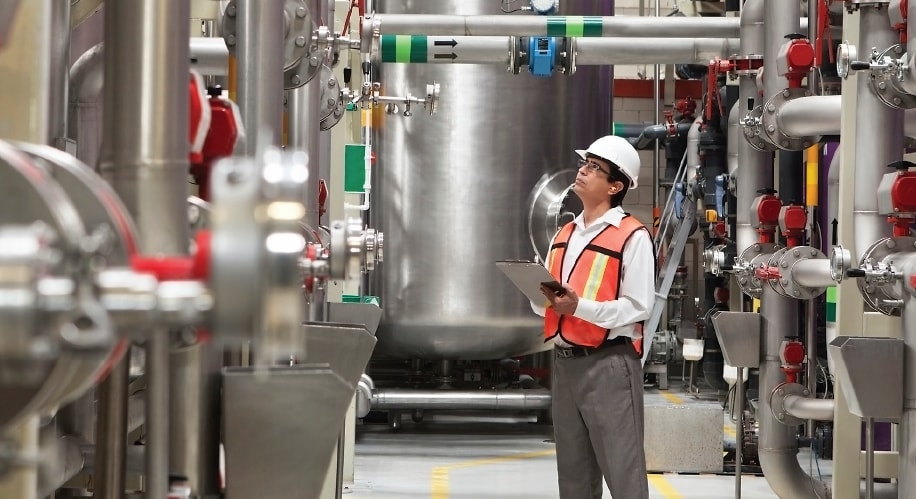
Integrated fire and life-safety oversight
October 28, 2017
By Taleen Merjanian

Oct. 28, 2017 – Industrial managers are responsible for keeping high-risk work environments safe and compliant while increasing productivity, simplifying management and controlling cost. To do so, they must take into consideration unique and wide-ranging challenges like the use of hazardous materials, complex machinery and evolving regulations.
To help maintain a safe environment while maximizing productivity, industrial managers should consider integrated, comprehensive system oversight that fosters accountability, efficiency and compliance across all active systems.
System design and installation
Industrial settings require tailored technology and safety solutions that meet a variety of code and regulatory standards, so technology installations benefit from a comprehensive vision and understanding of full system requirements. With multifaceted criteria to consider, it is advisable to work with experts who have a broad range of regulatory experience.
Without extensive industry expertise, specialized contractors may not adhere — or improperly adhere — to NFPA compliance standards that protect employees and operations. While some violations may be unnoticeable to the untrained eye, they could potentially cause a plant to shut down temporarily or put lives and property at risk. For example, when non-fire protection contractors install private fire service water supply mains, they may violate some requirements of NFPA 24: Standard for the Installation of Private Fire Service Mains and Their Appurtenances if they fail to install the required welded carbon steel pipe and install non-compliant pipe instead. If corrosion subsequently builds up within the pipe, the residue can clog nozzle heads or other critical valves, potentially preventing the water from flowing and thus, causing a system failure.
To avoid oversights, start with a professional risk assessment to help identify the unique threats and vulnerabilities in your facility. With close attention to detail, this assessment enables industrial managers to adopt the proper fire and life-safety solutions that meet their facility’s needs and mitigate risk without disturbing operations.
Testing and maintenance
Effectively managing an industrial facility is a balancing act between plant safety and productivity. Pressed for time and resources, it is easy to let day-to-day operations take precedence over tedious safety testing and maintenance. Working with a licensed fire and life-safety inspector to oversee full system maintenance improves accountability and frees industrial managers to focus on managing operations.
Additionally, with broad industry experience and continuous training on code changes, licensed inspectors can identify a potential violation or risk before disaster strikes, a shutdown is ordered, or costs escalate. When issues are identified early, it gives an opportunity to address problems in a cost-effective manner, mitigating hazards or code violations.
Control and monitoring
There are many reasons to implement an integrated, dedicated system to control and monitor all fire protection operations and activities. First, while many industrial facilities use PLCs or DCSs to monitor fire and life-safety systems, it is a code violation to do so. PLCs and DCSs are industrial computer control systems that continuously monitor devices and make decisions based upon a custom program to control the state of output devices. Standards set by the Underwriters Laboratories of Canada (ULC) require parts and components to be individually registered to the ULC. This helps ensure that critical parts and processes perform properly in the case of an emergency. If a system’s components are controlled by a separate PLC or DCS system, there is no assurance they will perform well together as designed, nor is it guaranteed they will perform in adverse conditions.
Additionally, a dedicated system enables you to test, maintain and repair life-safety systems without impeding or disrupting the DCS-controlled production systems that are essential to uptime, productivity and profitability. A DCS can be connected to fire systems to monitor information in a control room and help management make critical decisions, but it should never be used to control these systems.
Benefits of a single-source fire and life-safety provider
Industrial facilities present high-risk environments with unique challenges for facility managers who oversee fire and life-safety systems. The recommended course of action is to build a single-source relationship with a fire and life-safety provider that is responsible for the design and upkeep of all systems and equipment. Working with a single provider relieves facility managers from continually coordinating inspections, tests and maintenance.
With integrated, comprehensive fire and life safety system oversight in place, facility managers are better equipped to minimize disruption and focus on creating what matters most: a safe, secure environment, maximum efficiency and uptime, and a healthy bottom line.”
Taleen Merjanian, corporate marketing manager, has worked in the security and life safety industry with Johnson Controls (formerly Tyco Integrated Fire & Security) for over 20 years. In her role, she works with the Canadian division of Johnson Controls to provide comprehensive fire protection, security and life-safety solutions and services for businesses and large enterprises.
This column was originally published in the October 2017 issue of Manufacturing AUTOMATION.
Advertisement
- Summer in the rear view mirror
- Industrial cleaning with ice offers environmental advances and cost savings